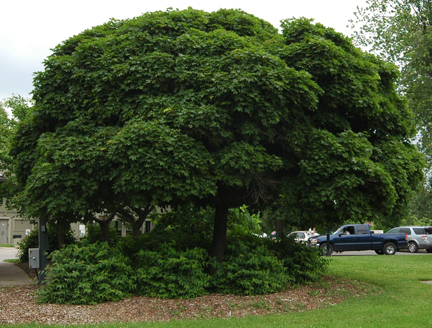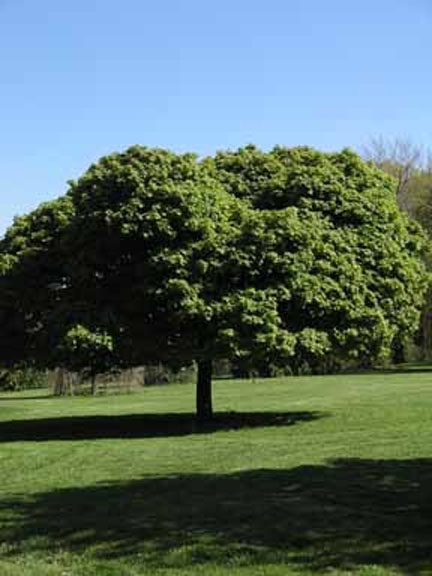
Woody > Acer > Acer platanoides > Acer platanoides 'Globosum'
Acer platanoides
'Globosum'
Globe Norway Maple
Origin: Discovered by Van Houtte in Belgium in 1873.

"
Acer platanoides 'Globosum' is an interesting tree to say the least. It shares many traits with the parent species but is different enough to make it unique. This plant shares similar bark and leaf charqacterisitics, but differs when it comes to canopy shape and overall growth. It grows much slower and smaller than the parent species, making it suitable for compact urban designs and small gardens. It is not invasive since it does not produce as many viable seed making it much more acceptable than some of the other cultivars and the species. A. platanoides 'Globosum' has a full, dense, dark green canopy in the spring but changes to a beautiful yellow in the autumn. It is a very versatile plant and is preferred over its parent tree for urban designs.
Michael Pascoe, NDP., ODH., CLT., MSc. (Plant Conservation)
"
| Family |
| Sapindaceae (Aceraceae) |
| Genus |
| Acer |
| Species |
| platanoides |
| Cultivar |
| 'Globosum' |
| Category |
| Woody |
| Type |
| Tree (deciduous) |
| Pronunciation |
| USDA Hardiness Zone |
| 4a-7a |
| Canadian Hardiness Zone |
| 5a-8 |
| RHS Hardiness Zone |
| H7 |
| Temperature (°C) |
| -35 |
| Temperature (°F) |
| -30 |
| Height |
| 5-7 m |
| Spread |
| 3-5 m |
| General Description |
| More of a showy tree compared to its parent plant. Has a very dense canopy when fully leaved out but can be quite bare and stubby after leaf drop. |
| Landscape |
| This particular cultivar grows much slower and smaller than the original Norway Maple. It can be used as a shade or street tree and is ideal where height and space is limited and is well adapted to the urban environment swith air pollution and compact soils. Globosum has a beautiful yellow canopy in the autumn which is unmatched by most other trees. |
| Cultivation |
| It does well in most soil types and pH levels in part shade/part sun as well as full sun light. It can handle moderate drought once established. It should be pruned annualy in the dormant season so that it does not become top heavy. |
| Shape |
| Upright round/spherical shaped canopy. |
| Growth |
| Slow |
| ID Characteristic |
| A tree with a very obvious globe/spherical shaped canopy spreading about the same width as it's heightl. It looks similar to Acer platanoides with regard to leaf shape and bark. |
| Pests |
| Aphids usually infest maples, especially Norway Maples. High populations of aphids can cause stress and leaf drop. Scale may be an occasional problem on Maples. It like most A. platanoides and its associated cultivars is prone to maple tar spot. |
| Habitat |
| Horticultural origin. |
| Bark/Stem Description |
| The bark is a brownish grey colour, not especially rough, but also not smooth. |
| Flower/Leaf Bud Description |
| The buds are usually about 4-6 mm long and are a red-brown to olive green colour while in bloom. |
| Leaf Description |
| The leaf is simple, between 8-20 cm long/wide and is palmate in shape and opposite in arrangement. In the spring and summer the leaves are a normal dark green colour but in autumn they turn a beautiful showy yellow that is hard to match. |
| Colour Description |
| The colour of the bark stays a brownish grey colour all year. The leaves after bloom are a normal dark green, but in the autumn they change into a beautiful yellow. The samaras are a green colour in the spring and summer and turn into a greenish brown in the autumn before they drop. |
| Texture Description |
| This is a medium textured plant and stays that way throughout the season. |
| Notable Specimens |
| Niagra Parks Botanical Gardens, Niagara Falls, Ontario, Canada. |
| Propagation |
| Often cultivars are grafted at around 2 m in height onto A. platanoides rootstock. |

